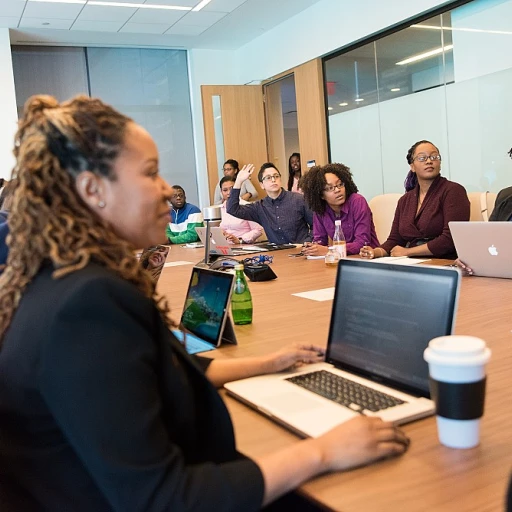
Understanding the Role of Leadership in Employee Engagement
The Leadership Effect on Employee Engagement
Leadership plays a pivotal role in the development of employee engagement within an organization. Strong leadership is often synonymous with healthy company culture, leading to committed and motivated team members. But how exactly do senior leaders influence engagement, and what should be examined to ascertain their effectiveness? A senior leader's influence extends to various facets of a business’s culture and operations. Their strategic decision-making forms the backbone of corporate goals, setting the tone for everyone involved. From long-term vision to short-term tasks, a company’s direction often pivots on the insight and foresight of these leaders. Employee engagement thrives when decision-making is transparent and aligns with the team's aspirations. However, it doesn’t stop at decision-making. Leaders must actively demonstrate a commitment to engagement through well-articulated goals and objectives that resonate with employee values. By doing so, they nurture an environment where strategic goals are not only understood but shared by all employees, leading to increased buy-in and drive to succeed. Lastly, leaders must evaluate their own leadership style. Understanding whether it encourages dialogue and collaboration can lead to significant improvements in engagement. Hence, assessing the current leadership style and its impact on team morale requires strategic questions aimed at uncovering potential barriers to effective leadership. Crafting an effective needs assessment template for employee engagement can help identify these areas for improvement. This is an excellent starting point to ensure that the leadership style aligns with the desired organizational culture and facilitates professional development for both the leaders and their teams.Key Questions to Assess Leadership's Commitment
Probing Leadership's Dedication to Engagement
Engagement is not just a box to be checked for senior leaders; it’s a crucial component of business success and long-term sustainability. Understanding a leader's commitment requires asking targeted questions to gauge their vision and priorities. Here are some strategic points to consider:- Vision and alignment: What are the senior leader's long-term goals for the company, and how do they align with employee engagement? Questions in this area might reveal whether the leadership team considers engagement an integral part of achieving their objectives.
- Culture and values: How does leadership instill company culture and values among team members? How are decision-making processes influenced by these values? Senior leaders should express transparency and a commitment to nurturing a positive company culture.
- Investment in development: Ask about the resources allocated for professional development and career advancement. Committing to employee growth is a sign of valuing their potential and ensuring long-term engagement within the organization.
- Balancing work and life: Inquire into initiatives or policies that promote work-life balance. Great leaders recognize the importance of life balance to maintain morale and productivity.
Evaluating Communication Strategies
Examining the Channels of Communication
When it comes to employee engagement, the way information flows within an organization can significantly impact how connected and motivated employees feel. It's essential for senior leaders to assess whether their communication strategies are effective in reaching all team members and fostering a sense of inclusion and transparency.
Here are some strategic questions to consider when evaluating communication:
- How frequently do leaders communicate the company's goals and vision to employees?
- What channels are being used for communication, and are they accessible to everyone in the organization?
- Is there a mechanism for employees to provide feedback or ask questions to senior management?
- Are senior executives actively listening to employee concerns and suggestions?
- How does the leadership style of the CEO and other senior leaders influence the communication culture?
These questions can help identify gaps in communication that might be affecting employee morale. For instance, if team members feel that their voices are not being heard, it could lead to disengagement. Therefore, it's crucial to ensure that communication is not just top-down but also allows for upward feedback.
By fostering open and transparent communication, senior leaders can create a more inclusive company culture that supports professional development and enhances work life balance. This approach not only boosts employee engagement but also aligns with the inspiring quotes to foster an engaged workforce, reinforcing the importance of effective communication in achieving long-term business success.
Measuring Impact of Leadership on Employee Morale
Assessing the Influence of Leadership on Employee Spirit
Understanding how senior leaders impact employee morale requires a strategic approach to evaluating various leadership elements. This process involves not only emphasizing the importance of direction and clarity but also looking at the broader picture including team dynamics within the organization. Here are some considerations to help assess this impact:- Evaluate Leadership Styles: Different leadership styles have varying effects on employees. Does your company culture support transformational leadership, which often raises employee engagement by encouraging creativity and innovation, or does it lean towards a more transactional approach, focusing on rewards and tasks? Understanding this can reveal how leaders influence the company's morale.
- Review Decision-Making Processes: Are decisions made inclusive of team members' input, or do they come from the top down? Engaging employees in decision-making can foster a sense of ownership and increase their commitment to company goals. Strategic questions around these processes can expose potential gaps or strengths in leadership's approach.
- Analyze Professional Development Initiatives: Leadership must prioritize career growth and professional development as part of their strategy. How often do team members engage in career-enhancing opportunities tailored by their leaders? Regular professional development can boost morale and show that senior executives value their employees' progression.
- Conduct Employee Surveys: Regular surveys aimed at understanding leadership's impact on work-life balance, communication effectiveness, and overall job satisfaction can provide honest feedback. These tools are crucial in identifying areas of improvement for senior leaders.
- Look for Consistency in Company Culture: Examining how consistently leaders uphold the organization's values and culture can shed light on their genuine commitment to employee engagement. When leaders embody the company culture, their actions and decisions are more likely to resonate positively with employees.
Identifying Opportunities for Leadership Development
Recognizing the Necessity for Leadership Growth
In any organization, the role of senior leaders is crucial in both setting the tone and driving the culture of the business. Leadership development is an ongoing process, and strategically enhancing the skills of leaders can deeply influence employee engagement.
To identify opportunities for growth, conducting regular evaluations of leadership styles and strategies is essential. These evaluations can reveal areas where senior leaders may need to adapt their approach, particularly in the ever-evolving landscape of management and digital transformation. Here are a few considerations:
- Professional Development: Encourage leaders to engage in professional development activities that align with both individual and organizational goals. Asking strategic questions can help identify the most beneficial paths for growth.
- Leadership Style Reflection: Periodically assessing leadership styles can provide insights into how they impact decision making and employee morale. Asking questions about how leaders perceive their roles can help tailor development programs.
- Feedback Integration: Leaders should leverage feedback from team members and senior executives as part of their development process. This feedback can point to areas of improvement and highlight strengths.
Furthermore, it's important to consider the long-term impact of leadership development on company culture. When leaders grow, they set an example for team members, fostering a culture of continuous improvement and engagement. By focusing on leadership growth, organizations can ultimately achieve a better work life balance and improve overall employee morale.
Creating a Culture of Continuous Feedback
Building a Feedback-Driven Culture
Creating a culture of continuous feedback is pivotal for enhancing employee engagement. It involves establishing an environment where feedback is not only welcomed but actively sought after by senior leaders and team members alike. This approach helps in aligning the company culture with the strategic goals of the organization.
Senior leaders play a crucial role in this process. Their leadership style should encourage open communication and foster a safe space for employees to express their thoughts and ideas. Here are some strategies to consider:
- Regular Check-ins: Encourage leaders to hold regular one-on-one meetings with their team members. These sessions should focus on both professional development and work-life balance, allowing employees to discuss their career goals and any challenges they might be facing.
- Feedback Loops: Implement structured feedback loops where employees can provide input on leadership decisions and company policies. This not only boosts morale but also helps in refining decision-making processes.
- Anonymous Surveys: Conduct anonymous surveys to gather honest feedback from employees about the leadership and management practices. This can help in identifying areas for improvement and recognizing great leaders within the organization.
- Recognition Programs: Establish recognition programs that celebrate achievements and contributions, reinforcing positive behavior and boosting employee engagement.
By integrating these strategies, senior executives can help cultivate a culture where feedback is seen as a tool for growth and improvement. This not only enhances the overall employee experience but also contributes to the long-term success of the business.













